by Joy Livingwell
Summary: A day of presentations and workshops, hosted yearly since 1987 at Burrows Ranch in Red Bluff, California, U.S.A. This year's topics included:
- Advantages of perennial grasses
- Establishing perennial grasses
- Goats for weed control
- Multi-species grazing, pastured hogs
| Rancher Bill Burrows explains carbon credits. This year's Stewardship Day was co-hosted by Burrows Ranch, Big Bluff Ranch, Tehama County Resource Conservation District, and Shasta College. It took place on May 4. |
Joy Livingwell
 |
Advantages of perennial grasses
| After 150 years of mismanagement, northern California's perennial range plants have almost disappeared. Today's range is mostly exotic annuals that die at the beginning of the rainless summers (brown areas). Big Bluff Ranch. |
Joy Livingwell
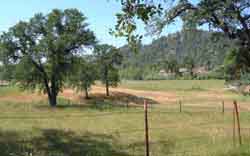 |
| By growing all summer, deep-rooted perennials (flat area) produce 3-10 times more forage per acre than annuals (hills). Rainfall is 300-1800 mm (12-72 inches), averaging 850 mm (34 inches), with a 6-month rainless period. Burrows Ranch. |
Joy Livingwell
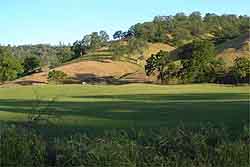 |
Establishing perennial grasses
Though they produce more forage than annuals, perennial grasses can be tough to establish. How-to article by Bill Burrows.
| Newly established Perla grass. In California's rainless summers, seedlings must grow roots faster than the soil moisture retreats, or they die. Burrows Ranch. |
Joy Livingwell
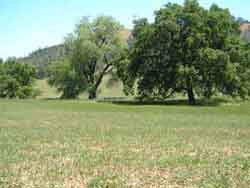 |
| Perennial grasses such as these Perla seedlings need protection from weed competition until they get established. Bill uses herbicides to control field bindweed and yellow star thistle the first season or two. Goats would also work, but currently cost him more than herbicides. After establishment, managed grazing controls weeds. |
Joy Livingwell
 |
| By late summer this 15-year-old stand of Perla grass will be 8 feet tall. Bill cuts it for hay, then grazes cattle on it. |
Joy Livingwell
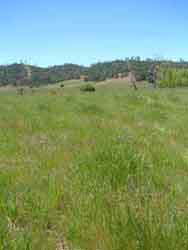 |
| Eric Beardsley explains research on carbon sequestering. While this annual grassland contains 652 lbs/acre (581 kg/ha) dry root mass, the Perla meadow in the previous picture contains 28,314 lbs/acre (25,271 kg/ha). |
Joy Livingwell
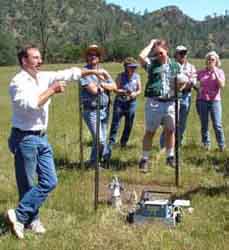 |
Goats for weed control
Goats actually prefer many problem plants to grass. Examples: field bindweed, yellow star thistle, and blackberries. They even eat poison oak.
| Tyler Dawley used goats to eat invasive blackberries that took over this waterway and crowded out native plants. Now-leafless blackberries are gray brush at left. The leaves do grow back and need to be browsed again. Big Bluff Ranch. |
Joy Livingwell
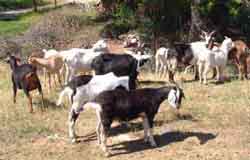 |
| Tyler Dawley's goats cleared a heavy infestation of yellow star thistle from the light area (yellow arrow). Bill says, "I would use the goats more if Tyler charged less." Burrows Ranch. |
Joy Livingwell
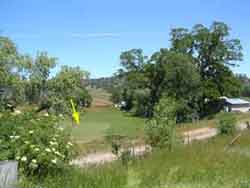 |
Shasta College: multi-species grazing
| Shasta College students explain their livestock projects, which include range chickens as well as mixed 'flerds' of sheep, cattle, and pigs. Sheep can escape coyotes by running among the Angus cattle -- but the college's coyote's no longer get hungry enough to attack because good management provides plenty of smaller animals for them to eat. Portable chicken coop at left contains black Leghorns, a wily egg-laying breed good at escaping predators. |
Joy Livingwell
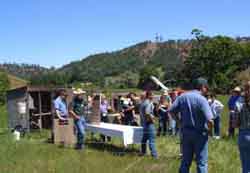 |
| Shasta College's "flerd" of sheep, cattle, and pigs. The pigs are specially bred to thrive on pasture. |
Joy Livingwell
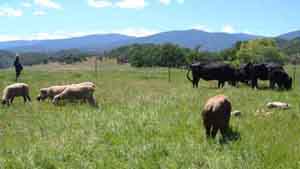 |
| Heritage breeds of hogs can live on pasture as nature intended. Since 1985, Shasta College has raised its own strain of Hereford-Duroc-York crossbreds. This sow gets a bit of grain to keep her body condition good while nursing. Otherwise she lives on pasture year-round. Don't try this with hogs from the sale barn; they are bred for confinement feeding, and will die on grass. |
Joy Livingwell
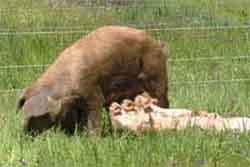 |
Pastured hogs don't have to be in fences to be profitable. Burrows Ranch now generates 73% of its income from hunting. Over half of that is wild boar hunts. The pigs are managed to maximize the number of mid-sized hogs produced. (More hunts mean more income; trophy animals take too long to grow.) Bill plants wheat for the hogs, an awnless variety that won't get stuck in the animals' mouths. Hunts are carefully orchestrated and command high prices -- roughly U.S. $500 per hog.